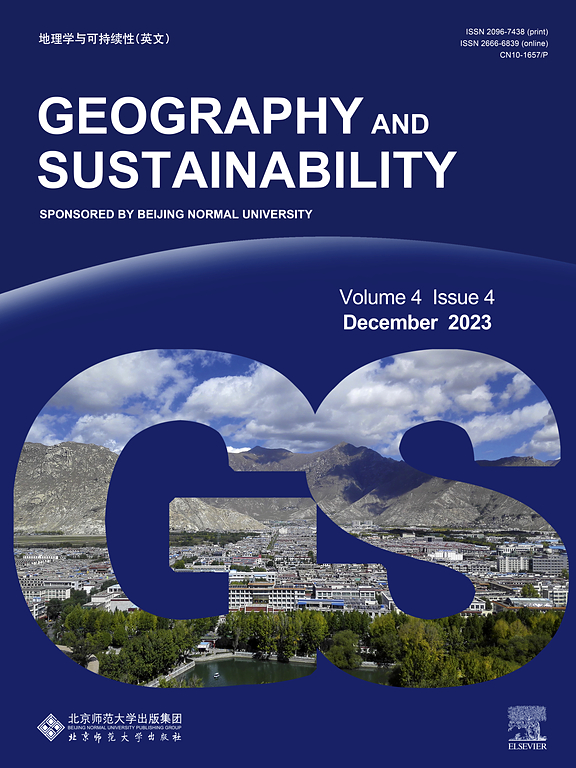IF 8
1区 环境科学与生态学
Q1 GEOGRAPHY, PHYSICAL
引用次数: 0
摘要
人类与野生动物冲突(HWC)及其社会经济影响是一个紧迫的全球性问题。准确量化人与野生动物冲突及其与住宅发展之间的相互作用对于乡村振兴和生物多样性保护工作至关重要。本研究利用高精度的年度土地利用/土地覆盖数据和亚洲象事故数据,调查了云南省南部农村住宅扩张(RRE)与人象冲突(HEC)之间的相互作用。研究采用片断回归方法,结合扩张强度、农村居民点用地率、居民点密度等指标,分析了农村居民点扩张的时空变化特征。然后,利用地理检测器和二元空间自相关模型揭示了RRE的驱动机制,特别是RRE与HEC之间的空间关系。结果表明,港珠澳大桥对 RRE 有显著的负面影响,非港珠澳大桥地区的农村居民点用地扩张强度和扩张速度均高于港珠澳大桥地区。从 2010 年开始,居民重新定居活动的加速与港珠澳大桥的强化在时空上高度一致,这与居民点扩张趋势的变化年份相吻合。RRE 活动和随之而来的土地用途转换导致了 HECs 的增加,从而对 RRE 产生了负面影响。相较于露天焚烧,地形和区位因素对 RRE 活动的影响次之。研究结果表明,在中国野生大象分布区内,RRE与HEC之间存在相互反馈机制,人象之间发生不利互动的风险升高,为协调亚洲象保护措施与中国西南边境地区乡村振兴提供了理论支持。本文章由计算机程序翻译,如有差异,请以英文原文为准。

Reciprocal regulation between rural settlement expansion and human-elephant conflict in China’s wild elephant range
Human-wildlife conflict (HWC) and its socioeconomic impacts are a pressing global issue. Accurately quantifying HWCs and their interaction with residential development is crucial for rural revitalization and biodiversity conservation efforts. This study investigates the interplay between rural residential expansion (RRE) with human-elephant conflict (HEC) in southern Yunnan Province using high-accuracy yearly land use/land cover data and Asian elephant accident data. A piecewise regression along with several metrics, including expansion intensity, rate of rural residential land, and residential density, were employed to analyze the spatial-temporal change characteristics of RRE. Then, a geographical detector and a bivariate spatial autocorrelation model were used to reveal the driving mechanisms of RRE, with particular emphasis on the spatial relations between RRE and HECs. The results indicate that HECs had a significant negative impact on RRE, exhibiting higher expansion intensity and rate of rural residential land in non-HEC areas than in HEC areas. High spatiotemporal consistency between accelerated RRE and intensified HECs occurred from 2010 onwards, which aligns with the year when the trend of settlement area expansion changed. RRE activities and ensuing land use conversions led to increased occurrences of HECs, which negatively affected the RRE. Compared to HECs, topography and locational factors exhibited a secondary effect on RRE activities. The findings underscore reciprocal feedback mechanisms between RRE and HECs and the elevated risk of adverse interactions between humans and elephants within the range of China’s wild elephants, providing theoretical support for coordinating conservation initiatives for Asian elephants with rural revitalization in the border areas of Southwest China.
求助全文
通过发布文献求助,成功后即可免费获取论文全文。
去求助
来源期刊

Geography and Sustainability
Social Sciences-Geography, Planning and Development
CiteScore
16.70
自引率
3.10%
发文量
32
审稿时长
41 days
期刊介绍:
Geography and Sustainability serves as a central hub for interdisciplinary research and education aimed at promoting sustainable development from an integrated geography perspective. By bridging natural and human sciences, the journal fosters broader analysis and innovative thinking on global and regional sustainability issues.
Geography and Sustainability welcomes original, high-quality research articles, review articles, short communications, technical comments, perspective articles and editorials on the following themes:
Geographical Processes: Interactions with and between water, soil, atmosphere and the biosphere and their spatio-temporal variations;
Human-Environmental Systems: Interactions between humans and the environment, resilience of socio-ecological systems and vulnerability;
Ecosystem Services and Human Wellbeing: Ecosystem structure, processes, services and their linkages with human wellbeing;
Sustainable Development: Theory, practice and critical challenges in sustainable development.
 求助内容:
求助内容: 应助结果提醒方式:
应助结果提醒方式:


